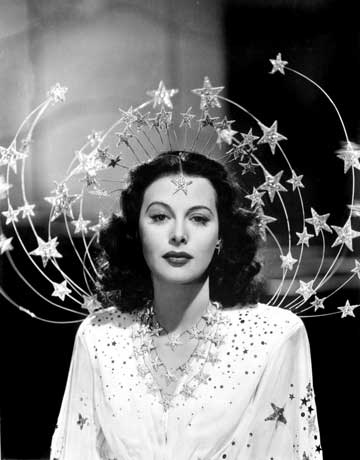Film (2017)
Documentary
Written and Directed by Alexandra Dean
Film Editing by Alexandra Dean, Penelope Falk, Lindy Jankura
Music by Jeremy Bullock, Keegan DeWitt
Kendall Square Cinema
Cambridge, MA

Image: Courtesy of Zeitgeist Films
Hedy Lamarr was drop dead gorgeous, and one of the premier film stars of her generation. Coming from Vienna in the 1930s, she took Hollywood by storm. Not at all known were two significant facts about her: she was Jewish, and she was brilliant.
During World War II, she worked with – again, an amazing fact – the avant-garde American composer George Antheil – to come up with a new and innovative technique for preventing radar communications from being jammed. She earned a patent for the technique, though it was not applied to technology until after the war. Though it has since been used extremely widely, due to particularities of patent law, Lamarr never reaped financial reward from her invention, and when she died she was more or less broke.
This quite comprehensive and informative documentary draws significantly on the fascinating account given in Hedy’s Folly: The Life and Breakthrough Inventions of Hedy Lamarr, the Most Beautiful Woman in the World (2012) by Richard Rhodes, which detailed Lamarr’s work with Antheil on the radar technology. That book represented an expansion upon research done by Rebecca Greenfield for an article in The Atlantic in 2010 entitled Celebrity Invention: Hedy Lamarr’s Secret Communications System. As well, the film features numerous interviews with family members and others who shed light on Lamarr’s brilliance and her idiosyncrasies.
As surprising and fascinating as it is to discover that Lamarr was an astonishingly brilliant inventor, the collaboration between her and Antheil is strikingly interesting as well. Though Lamarr had the idea that varying frequencies of radar transmission could make jamming nearly impossible, it was Antheil’s background in music, and particularly in the mechanics of player pianos, that contributed the idea of a method by which transmitting and receiving devices could be coordinated to register the appropriate changing frequencies at which communication should occur.
This combination of Lamarr’s vision of frequency alteration and Antheil’s conception of frequency registration calls to mind the famous innovations in chronometric technology in the mid-eighteenth century that enabled navigators to finally achieve breakthroughs in calculation of longitude.
This story of Lamarr’s brilliance as an inventor represents a good chunk of the documentary. As well, however, are accounts both of her profound influence as a Hollywood star and of her complicated family life.
Drawing significantly on interviews with her surviving children, now in late middle age, one gets a picture of a woman who was by turns extremely loving and prone to dismaying bouts of anger and alienating behaviors. Her first child, born out of wedlock during one of her early marriages – she had six in all before she was fifty – was eventually adopted by the child’s biological father. The other two children, whom Lamarr reared, speak warmly of her, though acknowledging the difficulties of life with her.
During the last decades of her life, Lamarr had an ultimately disfiguring series of plastic surgeries and she withdrew into almost total isolation. A poignant interview with her granddaughter, who saw Lamarr only twice, is evidence of the star’s retreat from the world at this stage of her life.
Nonetheless, during that late phase of retreat, in a phone interview with the journalist who discovered and publicized her radar invention, Lamar acknowledges the significance of it as perhaps her greatest contribution, well aware that her looks, for which she had become so well known, had offered a far more fragile and temporary kind of satisfaction.
The documentary refers to, but does not spend much time, on Lamarr’s Jewish background nor on her near denial of it as a Hollywood star. Though she expresses enormous love and enthusiasm for her father as a person, almost nothing about Jewishness emerges. This may not be surprising since Lamarr was seemingly from a quite assimilated Viennese Jewish family, but it would be interesting to know a bit more about her religious and cultural background and why she quite so completely suppressed information about it when she became well known.
– BADMan
Leave a Reply